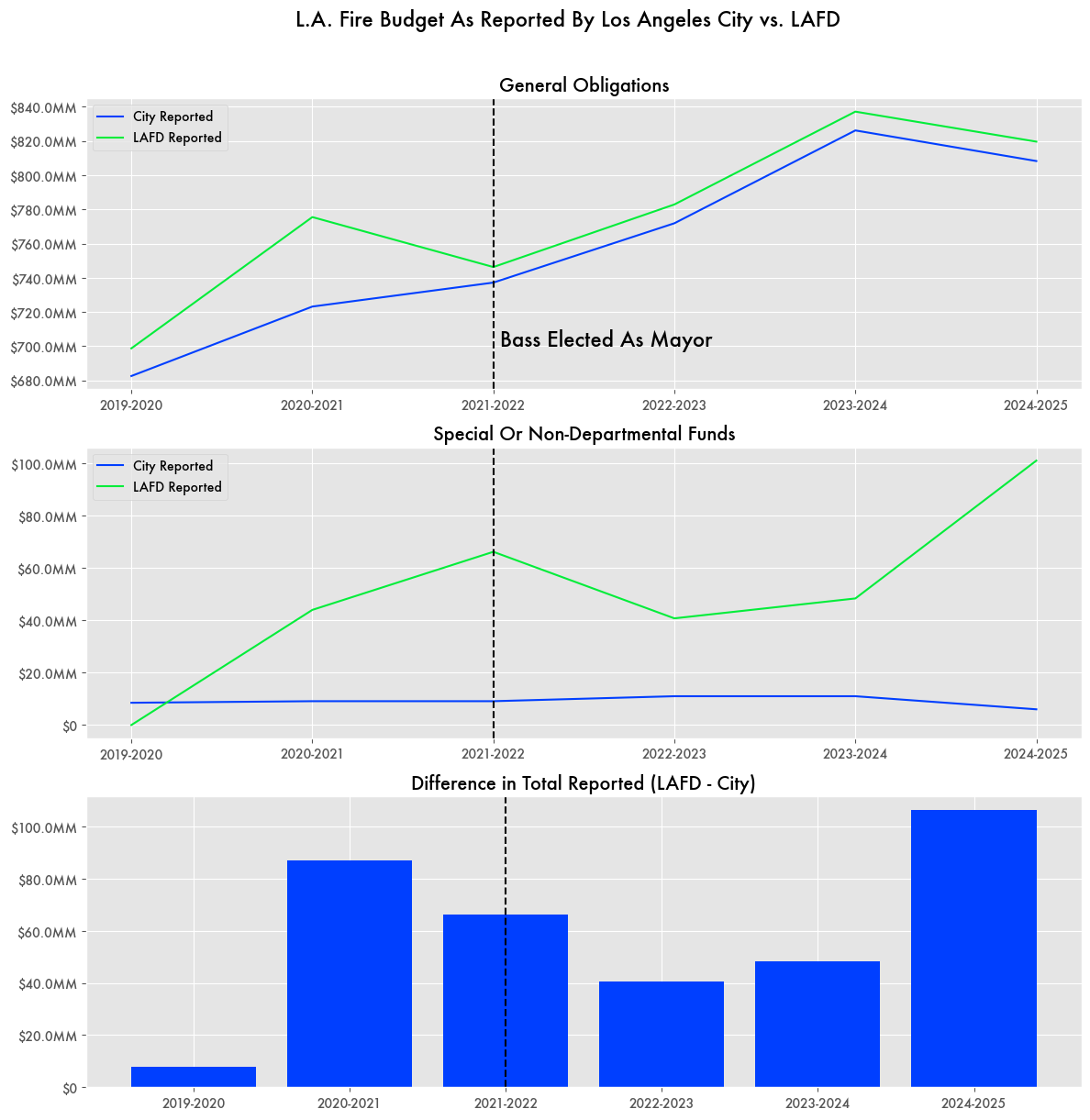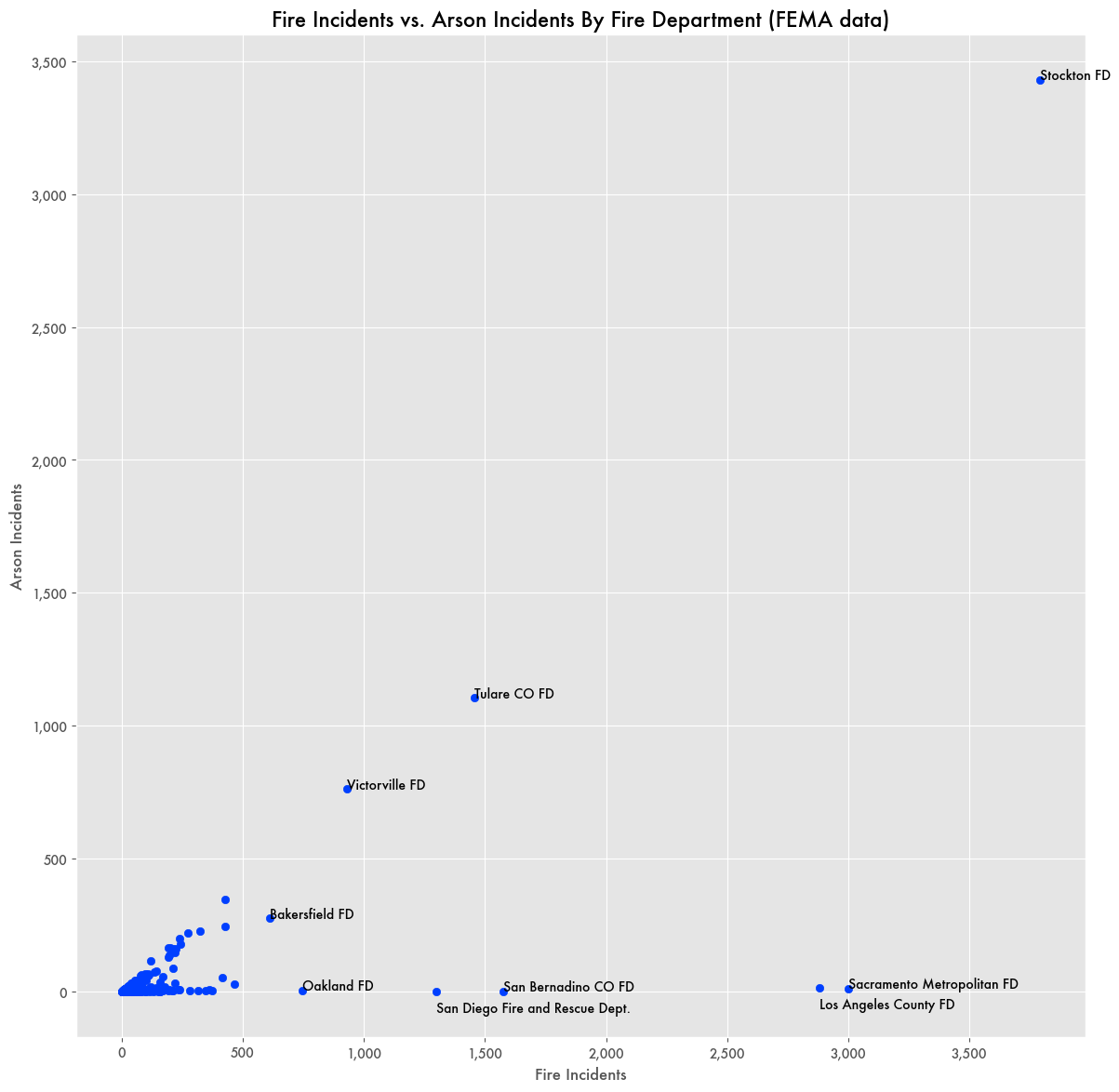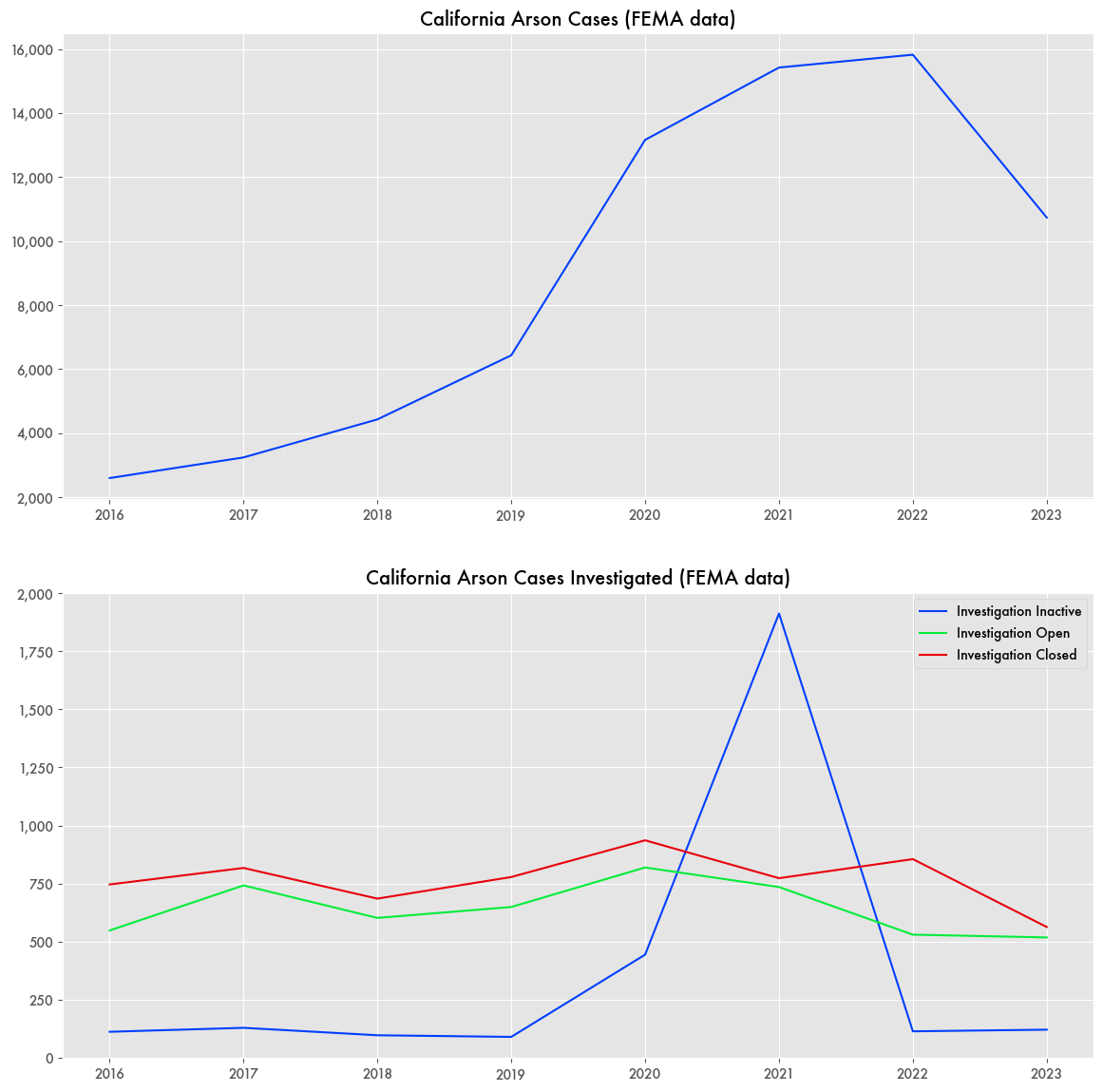L.A. Fire Roundup Part II: Budget Discrepancies, Diversity, And More Arson Reporting Oddities
LAFD Reported A Very Different Budget Total
One of the debates surrounding the L. A. Firestorm was whether the mayor, Karen Bass, cut the budget of the Los Angeles Fire Department (LAFD), hampering their ability to fight fires. There was a $17.5 million cut a year prior and potentially another $50 million cut discussed in recent weeks.
The fire department budget had been increasing for years. What was $691 million in 2019-2020 in total spending based on L.A. city budget summaries became $837 million in 2023-2024—a $146 million dollar increase—so maybe a $17 million decline wasn’t that significant.
But that was for the general obligation, or adopted, budget. There were also special or non-departmental funds going to the fire department on an annual basis.
For 2024-2025, non-departmental funds amounted to $101 million according to LAFD budget documents. But the city budget only lists $6 million in special funding for that year. General funds for LAFD effectively line up in both sources, but this other funding is considerably different.
Some of that $101 million in non-departmental funding for 2024-2025—$27 million worth—is coming from reimbursement for costs of ambulance services for Medi-Cal patients—the state Medicare program. Previous budgets have never mentioned this line item in their requests.
Yet the larger portion of that special funding is ostensibly money from other parts of the city budget, most of it dedicated to replacement of the department’s fleet of vehicles—ambulances and fire sedans.
That fund to replace LAFD vehicles has been part of their budget going back to 2020 and has varied from $20 million to $58 million each year.
On average, the non-departmental funds have been $51 million higher than what was reported in the city’s special appropriations for the fire department.
LAFD’s Diversity Budget
According to LAFD budget documents, the $17.5 million decline in the LAFD budget eliminated 58 civilian regular authority positions, but also included eliminations or changes to various resolution authorities, sworn salary accounts, and various expense accounts. Of that, $7 million was a reduction in overtime hours.
In a letter to the mayor, fire chief Kristen Crowley lamented the changes to the budget:
These budgetary reductions have adversely affected the Department’s ability to maintain core operations, such as technology and communication infrastructure, payroll processing, training, fire prevention, and community education.
What wasn’t mentioned in that list was mechanics, although it was buried further down in the budget document. In an interview with local TV news affiliate Fox11, the chief described how their inability to repair vehicles because of the budget cuts hampered their ability to fight fires. A reported 75 of the department’s trucks were out of commission and needing repairs.
While positions like mechanics were not funded, the LAFD used what funds they did have to continue $1.8 million worth of equity and inclusion staffing positions.
Although, in general, the LAFD appears to pay a lot of money to their staff. Their 2023-2024 budget lists total salaries at $781 million. Their website list 3,599 uniformed fire and support personnel. That works out to an average salary and benefits of $217,004 per person, with over 40 percent going towards overtime pay.
Los Angeles Fire Department Wasn't Reporting Arson to FEMA
In a previous story, Investigative Economics reported on the wide fluctuation in California and Los Angeles arson data, along with a wide gap in FBI reporting around 2021.
Based on California Department of Justice (DOJ) data, the city of Los Angeles had 3,531 reported incidents of arson in 2022 that would drop to 179 a year later.
While the drop to 179 incidents was suspicious, it wasn’t zero. But zero is the number of arson incidents that the Los Angeles Fire Department was reporting to the Federal Emergency Management Agency (FEMA).
FEMA maintains the National Fire Incident Reporting System (NFIRS) to track fire department responses to incidents across the country. Being the largest city in the country, Los Angeles city stands out for the largest number of reported fires in California in 2023 (4,423) and the fifth largest nationwide by fire department. Number one is Philadelphia.
But none of those fires in L.A. were reported as arson—something that is incredibly unlikely.
Besides the accusations of arson surrounding the most recent firestorm in Los Angeles, the city has investigated numerous cases of arson in recent years, many more listed as “undetermined,” and prominently lists them on the LAFD website.
In 2021, there were approximately 17,000 fires in the City. Statistics include approximately:
3,744 - Intentional Fires
2,025 - Unintentional Fires
8,654 - Undetermined Fires
2,577 - Other
837 - Cases investigated by ACTS
262 - Cases Cleared by an Arrests
32 - Fatality Fires
That number of intentional fires in one year is astounding by itself. It’s 200 more than what was reported by the California DOJ for that year and more than twice that was reported in 2019.
It dwarfs anything in the FEMA dataset except for one—Stockton, California (3,430)—which might have a significant arson problem considering that it is one-tenth the size of Los Angeles in terms of population.
Stockton might have a substantial arson problem but they don’t have a reporting problem—91 percent of fires are listed as intentionally set.
Fire departments within the county of Los Angeles—which includes Los Angeles city but also other cities and has over twice the population—might also have a FEMA reporting issue. Since 2017, it has averaged 15,702 fire incidents a year (standard deviation: 412), but at most 5 percent are considered arson.
In general, there is a whole set of fire departments that report arson at a similar rate—less than one percent of all fires—yet have a lot of fires—over 500 a year.
These are the fire departments in major cities like San Diego, San Bernadino, Sacramento, and Oakland. Then there’s another set of cities that report at a much more significant rate like Stockton—50 to 90 percent of incidents. That includes more rural California locations like Tulare County, Victorville, and Bakersfield.
State Arson Rates
Both FEMA data and state DOJ data show a similar trend of a statewide arson rampage beginning somewhere near 2019 but dropping off in 2022. But the Bureau of Alcohol Tobacco and Firearms (ATF) shows something completely different.
Their data shows a consistent decline in “intentional” fires in California going back to 2016 based on their Arson Incident Reports. ATF-reported arsons in the state are now less than 200 a year.
The reports do warn that their numbers should not be compared with that of the FBI’s as not all events are reported to the ATF, and their numbers are usually around 20 percent of the FBI numbers.
But the ATF numbers for California are much smaller than that—on the order of 2 percent of the FBI’s numbers. The 2021 California arson rampage doesn’t even show up as a bump through the ATF’s Bomb Arson Tracking System (BATS) reporting system.
According to a report from the California DOJ, they still don’t know why arson suddenly declined in 2023.
Inactive Arson Investigations
How much arson may be occurring in California may be beside the point as the FEMA data appears to show that many of the cases reported around the 2021 spike simply went inactive.
Usually only a couple hundred arson cases are left inactive a year as 500 to 800 cases are closed. But in 2021 a full 1,912 cases were left inactive, with no real sign that any of them led to an arrest.




